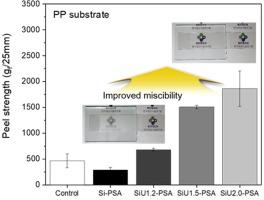当前位置:
X-MOL 学术
›
Eur. Polym. J.
›
论文详情
Our official English website, www.x-mol.net, welcomes your
feedback! (Note: you will need to create a separate account there.)
Adhesion improvement of the acrylic pressure-sensitive adhesive to low-surface-energy substrates using silicone urethane dimethacrylates
European Polymer Journal ( IF 5.8 ) Pub Date : 2020-08-01 , DOI: 10.1016/j.eurpolymj.2020.109949 Hee-Woong Park , Hyun-Su Seo , Jung-Hyun Lee , Seunghan Shin
European Polymer Journal ( IF 5.8 ) Pub Date : 2020-08-01 , DOI: 10.1016/j.eurpolymj.2020.109949 Hee-Woong Park , Hyun-Su Seo , Jung-Hyun Lee , Seunghan Shin

|
Abstract The acrylic pressure-sensitive adhesive (acrylic PSA) shows satisfactory adhesion to high-surface-energy substrates, such as glass, metal, and SUS, but it shows very low adhesion to low-surface-energy substrates, such as polyethylene, polypropylene, and polydimethylsiloxane (PDMS). To increase the adhesion strength of PSA to the low-surface-energy substrates, silicone dimethacrylate (SiDMA) was added to decrease the surface energy of the PSA, but it induced degraded peel strength due to plasticization and miscibility problems. In this study, various types of silicone urethane dimethacrylates (SiUDMAs) were synthesized by controlling the ratio of diisocyanate to PDMS to overcome the miscibility problem. As the ratio increased, their molecular weight and viscosity decreased, but their surface energy increased due to the reduced PDMS content. With the addition of SiUDMA2.0, which has a similar molecular weight to SiDMA, PSA showed 4- and 6-times higher loop tack and peel strength, respectively, on the PDMS substrate without UV curing. All types of SiUDMAs lowered the surface energy of the PSA and significantly increased the loop tack and peel strength on the PE, PP, and PDMS substrates. On the PDMS substrate, PSA that was modified with 20 wt% of SiUDMA2.0 and cured at 200 mJ/cm2 showed a peel strength of 520 gf/25 mm, which was more than 3 times higher than that of the control PSA (138 gf/25 mm). The shear adhesion failure test showed that SiUDMA2.0-modified PSA endured a temperature of 70 °C, which is higher than the 46.5 °C of the control PSA.
中文翻译:

使用有机硅氨基甲酸酯二甲基丙烯酸酯改善丙烯酸压敏胶对低表面能基材的附着力
摘要 丙烯酸压敏胶(丙烯酸 PSA)对玻璃、金属和 SUS 等高表面能基材表现出令人满意的附着力,但对聚乙烯、聚丙烯等低表面能基材的附着力非常低。 , 和聚二甲基硅氧烷 (PDMS)。为了提高 PSA 对低表面能基材的粘合强度,添加了有机硅二甲基丙烯酸酯 (SiDMA) 以降低 PSA 的表面能,但由于增塑和混溶问题导致剥离强度降低。在本研究中,通过控制二异氰酸酯与 PDMS 的比例来克服混溶性问题,合成了各种类型的有机硅氨基甲酸酯二甲基丙烯酸酯 (SiUDMA)。随着比例的增加,它们的分子量和粘度降低,但由于 PDMS 含量降低,它们的表面能增加。通过添加与 SiDMA 分子量相似的 SiUDMA2.0,PSA 在未经 UV 固化的 PDMS 基材上的环粘性和剥离强度分别提高了 4 倍和 6 倍。所有类型的 SiUDMA 都降低了 PSA 的表面能,并显着提高了 PE、PP 和 PDMS 基材上的环粘性和剥离强度。在 PDMS 基材上,用 20 wt% SiUDMA2.0 改性并以 200 mJ/cm2 固化的 PSA 表现出 520 gf/25 mm 的剥离强度,比对照 PSA(138 GF/25 毫米)。剪切粘附破坏试验表明,SiUDMA2.0 改性的 PSA 可承受 70°C 的温度,高于对照 PSA 的 46.5°C。分别在没有 UV 固化的 PDMS 基板上。所有类型的 SiUDMA 都降低了 PSA 的表面能,并显着提高了 PE、PP 和 PDMS 基材上的环粘性和剥离强度。在 PDMS 基材上,用 20 wt% SiUDMA2.0 改性并以 200 mJ/cm2 固化的 PSA 表现出 520 gf/25 mm 的剥离强度,比对照 PSA(138 GF/25 毫米)。剪切粘附破坏试验表明,SiUDMA2.0 改性的 PSA 可承受 70°C 的温度,高于对照 PSA 的 46.5°C。分别在没有 UV 固化的 PDMS 基板上。所有类型的 SiUDMA 都降低了 PSA 的表面能,并显着提高了 PE、PP 和 PDMS 基材上的环粘性和剥离强度。在 PDMS 基材上,用 20 wt% SiUDMA2.0 改性并以 200 mJ/cm2 固化的 PSA 表现出 520 gf/25 mm 的剥离强度,比对照 PSA(138 GF/25 毫米)。剪切粘附破坏试验表明,SiUDMA2.0 改性的 PSA 可承受 70°C 的温度,高于对照 PSA 的 46.5°C。0 并在 200 mJ/cm2 下固化显示出 520 gf/25 mm 的剥离强度,比对照 PSA (138 gf/25 mm) 高 3 倍以上。剪切粘附破坏试验表明,SiUDMA2.0 改性的 PSA 可承受 70°C 的温度,高于对照 PSA 的 46.5°C。0 并在 200 mJ/cm2 下固化显示出 520 gf/25 mm 的剥离强度,比对照 PSA(138 gf/25 mm)高 3 倍以上。剪切粘附破坏试验表明,SiUDMA2.0 改性的 PSA 可承受 70°C 的温度,高于对照 PSA 的 46.5°C。
更新日期:2020-08-01
中文翻译:

使用有机硅氨基甲酸酯二甲基丙烯酸酯改善丙烯酸压敏胶对低表面能基材的附着力
摘要 丙烯酸压敏胶(丙烯酸 PSA)对玻璃、金属和 SUS 等高表面能基材表现出令人满意的附着力,但对聚乙烯、聚丙烯等低表面能基材的附着力非常低。 , 和聚二甲基硅氧烷 (PDMS)。为了提高 PSA 对低表面能基材的粘合强度,添加了有机硅二甲基丙烯酸酯 (SiDMA) 以降低 PSA 的表面能,但由于增塑和混溶问题导致剥离强度降低。在本研究中,通过控制二异氰酸酯与 PDMS 的比例来克服混溶性问题,合成了各种类型的有机硅氨基甲酸酯二甲基丙烯酸酯 (SiUDMA)。随着比例的增加,它们的分子量和粘度降低,但由于 PDMS 含量降低,它们的表面能增加。通过添加与 SiDMA 分子量相似的 SiUDMA2.0,PSA 在未经 UV 固化的 PDMS 基材上的环粘性和剥离强度分别提高了 4 倍和 6 倍。所有类型的 SiUDMA 都降低了 PSA 的表面能,并显着提高了 PE、PP 和 PDMS 基材上的环粘性和剥离强度。在 PDMS 基材上,用 20 wt% SiUDMA2.0 改性并以 200 mJ/cm2 固化的 PSA 表现出 520 gf/25 mm 的剥离强度,比对照 PSA(138 GF/25 毫米)。剪切粘附破坏试验表明,SiUDMA2.0 改性的 PSA 可承受 70°C 的温度,高于对照 PSA 的 46.5°C。分别在没有 UV 固化的 PDMS 基板上。所有类型的 SiUDMA 都降低了 PSA 的表面能,并显着提高了 PE、PP 和 PDMS 基材上的环粘性和剥离强度。在 PDMS 基材上,用 20 wt% SiUDMA2.0 改性并以 200 mJ/cm2 固化的 PSA 表现出 520 gf/25 mm 的剥离强度,比对照 PSA(138 GF/25 毫米)。剪切粘附破坏试验表明,SiUDMA2.0 改性的 PSA 可承受 70°C 的温度,高于对照 PSA 的 46.5°C。分别在没有 UV 固化的 PDMS 基板上。所有类型的 SiUDMA 都降低了 PSA 的表面能,并显着提高了 PE、PP 和 PDMS 基材上的环粘性和剥离强度。在 PDMS 基材上,用 20 wt% SiUDMA2.0 改性并以 200 mJ/cm2 固化的 PSA 表现出 520 gf/25 mm 的剥离强度,比对照 PSA(138 GF/25 毫米)。剪切粘附破坏试验表明,SiUDMA2.0 改性的 PSA 可承受 70°C 的温度,高于对照 PSA 的 46.5°C。0 并在 200 mJ/cm2 下固化显示出 520 gf/25 mm 的剥离强度,比对照 PSA (138 gf/25 mm) 高 3 倍以上。剪切粘附破坏试验表明,SiUDMA2.0 改性的 PSA 可承受 70°C 的温度,高于对照 PSA 的 46.5°C。0 并在 200 mJ/cm2 下固化显示出 520 gf/25 mm 的剥离强度,比对照 PSA(138 gf/25 mm)高 3 倍以上。剪切粘附破坏试验表明,SiUDMA2.0 改性的 PSA 可承受 70°C 的温度,高于对照 PSA 的 46.5°C。









































 京公网安备 11010802027423号
京公网安备 11010802027423号